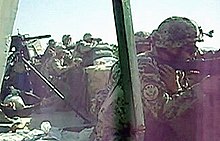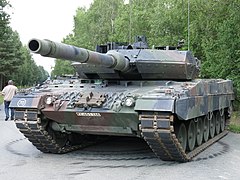German Army
| German Army | ||
|---|---|---|
| Heer | ||
 Logo of the German Army | ||
| Founded | 11 November 1955 | |
| Country | ||
| Type | Land force | |
| Size |
| |
| Part of | Bundeswehr | |
| Army Command | Strausberg | |
| Motto(s) |
| |
| Anniversaries | 12 November 1955 | |
| Equipment | List of equipment | |
| Engagements |
| |
| Decorations | Federal Chancellor | |
Trainer helicopter | Eurocopter EC135 | |
| Utility helicopter | NH90 | |
The German Army (
History
| Bundeswehr |
|---|
|
Branches (Teilstreitkräfte) |
|
|
|
Organisational areas (Organisationsbereiche) |
|
Cyber and Information Space |
Overview
A German army equipped, organized, and trained following a single doctrine and permanently unified under one command was created in 1871 during the
After World War II, Germany was divided into the Federal Republic of Germany (West Germany) and the German Democratic Republic (East Germany), which both formed their own armed forces: on 12 November 1955 the first recruits began their service in the West German Heer, while on 1 March 1956 the East German Landstreitkräfte der NVA (Land Forces of the National People's Army) were founded. During the Cold War, the West German Army was fully integrated into NATO's command structure while the Landstreitkräfte were part of the Warsaw Pact. Following the process of German reunification in 1990, the Landstreitkräfte were partially integrated into the German Army. Since then, the German Army has been employed in peacekeeping operations worldwide and since 2002 also in combat operations in Afghanistan as part of NATO's International Security Assistance Force.
Founding of the Army
Following World War II the
The army saw itself explicitly not as a successor to the defeated
The official date of the founding of the army is 12 November 1955 when the first soldiers began their service in
Also in 1957 the "Office for Territorial Defence" was established as the highest Territorial Army authority. The Office for Territorial Defence was under the direct command of the Federal Ministry of Defence and commanded the Territorial Army (Germany) (Territorialheer), a reserve formation. While the Heer along with the Marine and Luftwaffe were firmly integrated into the NATO Military Command Structure, the Territorialheer remained under national command. The main function of the Territorialheer was to maintain the operational freedom of NATO forces through providing rear area defence against saboteurs, enemy special forces, and the like. There were three Territorial Commands (Territorialkommandos), including North, South, and Schleswig-Holstein, and up to six Wehrbereichskommandos (WBKs), military regional commands.[7] By 1985 each of the WBKs had two Heimatschutzbrigades (HSBs, home defence brigades).

The development of Soviet tactical nuclear weapons required the development of a new Army structure even before Army Structure 1 was fully achieved. To minimize the effects of attacks with tactical nuclear weapons on massed forces, the 28,000 strong divisions of the Heer were broken up into smaller and more mobile brigades under Army Structure 2. These smaller units were also to be capable of self-sustainment on a nuclear battlefield for several days, and to be capable of moving quickly from defense and to attack. The new armoured and mechanised brigades were capable of combined arms combat. Each division was composed of three brigades. The armoured brigades consisted of an armoured infantry battalion, two armoured battalions, a self-propelled artillery battalion and a supply battalion. The mechanised brigades consisted of a motorised infantry battalion, two mechanised infantry battalions, an armoured battalion, a field artillery battalion and a supply battalion. The motorised brigades consisted of three motorised infantry battalions, an anti-tank battalion, a field artillery battalion and a supply battalion. The alpine brigades consisted of three alpine battalions, a mountain artillery battalion and a supply battalion. By 1959 the Heer consisted of 11 divisions of 27 brigades, four Panzer (armoured), four Panzergrenadier (mechanised), two Jäger (motorised), and one Gebirgsjäger (alpine).
From roughly 1970 onward, Army Structure 3 saw the targeted number of 36 active brigades raised by 1975 while the 2nd and 4th Panzergrenadier divisions were reorganised into Jäger formations. The armies Fallschirmjäger (paratrooper) brigades were renamed into Luftlande (airborne) brigades and a third brigade (Luftlandebrigade 27) was formed.
Under Army Structure 4 from 1980/81 on, the German Army fielded 12 divisions (with 38 active brigades): six Panzer (armoured), four Panzergrenadier (mechanised), one Luftlande (airborne), and one Gebirgs (alpine) divisions. Ten active divisions were grouped into three corps:
The number of active brigades rose compared to Army Structure 3 due to two Heimatschutz territorial defense brigades (51 and 56) being assigned to the field army as part of a mechanised and mountain division respectively. The non-NATO assigned territorial army formed 10 further territorial defense brigades for rear area security at varying readiness levels, with most units being partially manned in peacetime and others being entirely non-active units with equipment in storage.
Brigades in the field army grew to four combat battalions instead of three. Mechanised brigades typically consisted of one Panzer and three Panzergrenadier battalions, of which one was a partially active and mixed formation, containing a tank company and two mechanised companies. Armoured brigades similarly consisted of one Panzergrenadier and three Panzer battalions, with one armoured battalion being mixed and partially active (containing one mechanised and two tank companies).
Mechanised infantry battalions in mechanised brigades typically had one of three companies equipped as motorised infantry with M113 APCs instead of Marder IFVs.
Post Cold War

After 1990, the Heer absorbed the
Logistics, CBRN defense, territorial defense and military police units were split off into the newly formed Joint Support Service and medical units into the Joint Medical Service in 2000. The transferred units continue to wear army uniforms.
The 2001 onwards restructuring of the German Army saw it move to a seven division structure – five mechanised (each with two mechanised brigades), one special forces, and one air assault.
In 2003, three Corps still existed, each including various combat formations and a maintenance brigade, as well as the
The IV Corps was headquartered at Potsdam in eastern Germany and controlled two Panzergrenadier Divisions, the 13th and 14th. The 14th Panzergrenadier Division also took control of units in Western Germany re-subordinated from the 6th Panzergrenadier Division when it lost its command function. It would have made up the German contribution to the Multinational Corps Northeast in time of war. IV Corps also used to have under its command the Military District Command I, the 1st Airmobile Brigade, and the Berlin Command (de:Standortkommando Berlin).
The current structure was assumed with the most recent German Army reform which also suspended conscription by 1 July 2011[10] and saw the army move to a purely professional three division structure with a view on creating smaller, more flexible and more deployable units, emphasising global employment against non-state threats such as international terrorism or as part of UN and EU missions.[11]
As of January 2022[update], the German Army had a strength of 62,766 soldiers.[1]
Structure and organisation
(13 Light Brigade

The German Army is commanded by the Inspector of the Army (Inspekteur des Heeres) based at the Army Command (Kommando Heer) in Strausberg near Berlin. The training centers are supervised by the Army Training Command in Leipzig.
The combat units of the army now include two armoured divisions and the lighter rapid forces division. Unlike other European armies such as neighbouring France, regiments are not a common form of organization and are thus rare in the German army. Battalions and regiments are directly subordinate to brigades or to divisions as divisional troops. German infantry battalions field 1,000 men, considerably larger than most NATO armies. While some brigades are still designated as either Panzer (armour) or Panzergrenadier (mechanised infantry) formations, these names are by now traditional and no longer imply a different organisation, for example an armoured brigade would not be expected to contain more tanks than a mechanised one.
 1. Panzerdivision in Oldenburg
1. Panzerdivision in Oldenburg
- Panzerlehrbrigade 9, in Munster
- Panzer Brigade 21, in Augustdorf
- Panzergrenadier Brigade 41, in Neubrandenburg
- 43 Mechanized Brigade (Royal Netherlands Army), in Havelte (Netherlands)
- Divisional troops
 10. Panzerdivision, in Veitshöchheim
10. Panzerdivision, in Veitshöchheim
- Panzer Brigade 12, in Cham
- 13 Light Brigade (Royal Netherlands Army), in Oirschot (Netherlands)
- Panzergrenadier Brigade 37, in Frankenberg
- Franco-German Brigade, in Müllheim
- Divisional troops
 Rapid Forces Division, in Stadtallendorf
Rapid Forces Division, in Stadtallendorf
- Airborne Brigade 1, in Saarlouis
- 11 Airmobile Brigade (Royal Netherlands Army), in Schaarsbergen (Netherlands)
- Gebirgsjäger Brigade 23, in Bad Reichenhall
- Special Forces Command (KSK), in Calw
- Helicopter Command, in Bückeburg
- Divisional troops
 Eurocorps (German elements), in Strasbourg (France)
Eurocorps (German elements), in Strasbourg (France)
- Command Support Brigade
- German elements in two permanent battalions and one staff company
- Command Support Brigade
- 1 (German/Netherlands) Corps, in Münster
- German elements in two permanent battalions and one staff company
- Multinational Corps North East, in Szczecin(Poland)
- 610th Signal Battalion, in Prenzlau
 Central Army Depot, in Herongen
Central Army Depot, in Herongen Central Army Depot, in Pirmasens
Central Army Depot, in Pirmasens Central Mobilisation Base, in Brück
Central Mobilisation Base, in Brück

Equipment
-
Leopard 2A6main battle tank
-
PzH2000 self-propelled artillery
-
NH-90 transport helicopter
-
Pumainfantry fighting vehicle
Further vehicles include:
Armoured personnel carrier and fighting vehicles:
- Puma (IFV) infantry fighting vehicle
- Boxer (armoured fighting vehicle)
- TPz Fuchs as armoured personnel carrier
- ATF Dingo as armoured infantry mobility vehicle
Trucks:
- Mercedes-Benz Zetros off-road transport truck
- MAN KAT1 high-mobility off-road truck
- Unimog all-wheel drive army personnel or equipment carriers
Truppengattungen
The German Army is divided into several branches, each known as a Truppengattung, which might also be part of a Truppengattungsverbund which includes several Truppengattungen. Each Waffengattung carries a certain beret color (except for the mountain troops, who carry a
| Truppengattungsverbund | Truppengattung | Beret color | Waffenfarbe |
|---|---|---|---|
| Infantry | Green | ||
| Bergmütze | |||
| Bordeaux | |||
| Panzer forces | Green | ||
| Black | |||
| Special forces | Bordeaux | ||
| Artillery | Light Red | ||
| Army aviation | Bordeaux | ||
| Military engineers | Light Red | ||
| Signals troops | Light Red | ||
| Army reconnaissance | Black | ||
| Army logistics | Light Red | ||
| Light Red | |||
| Army medical service | Dark Blue |
As part of various reorganizations (such as the creation of the Joint Support Service and the Cyber and Information Domain Service) and the reductions in size of the Bundeswehr after 1990, several Truppengattungen were dissolved.
| Truppengattung | Beret color | Waffenfarbe | Fate |
|---|---|---|---|
| Light Red | Passed from the army to the Joint Support Service. | ||
| Light Red | Passed from the army to the Joint Support Service. | ||
| Black | Dissolved; folded into the Aufklärungstruppe. | ||
| Dark Blue | Passed from the army to the Cyber and Information Domain Service. | ||
| Black | Dissolved; folded into the Aufklärungstruppe. | ||
| Light Red | Dissolved; anti-air defense largely left to the responsibilities of the German Air Force. | ||
Militärmusikdienst (Military music service)
|
Various | Passed from the army to the Joint Support Service. | |
| Dark Blue | Passed from the army to the Cyber and Information Domain Service. | ||
| Black | Dissolved; folded into the Aufklärungstruppe. | ||
| Black | Dissolved; folded into the Panzertruppe. | ||
| Light Red | Dissolved in 2004; restructured as the Geo Information Service. |
Waffenfarbe (Army and army support branch only)
-
NBC
-
Artillery
-
Armored forces
-
Reconnaissance
-
Signals
-
Infantry
-
Technical Troops
-
Medical troops
-
Military band
-
Army engineers
- Bright Red: General ranks (only Kragenspiegel, not Litze),
- Crimson: General Staff
Rank structure
The rank structure of the German army is adjusted to the rank structure of
- Officers
| NATO code | OF-10 | OF-9 | OF-8 | OF-7 | OF-6 | OF-5 | OF-4 | OF-3 | OF-2 | OF-1 | OF(D) | Student officer | ||||||||||||||||||||||||
|---|---|---|---|---|---|---|---|---|---|---|---|---|---|---|---|---|---|---|---|---|---|---|---|---|---|---|---|---|---|---|---|---|---|---|---|---|

|

|

|

|

|

|

|

|

|

|

|

|

|

|
Enlisted rank plus bottom thin silver cord indicating cadet's career | ||||||||||||||||||||||
| General | Generalleutnant | Generalmajor | Brigadegeneral | Oberst | Oberstleutnant | Major | Stabshauptmann | Hauptmann | Oberleutnant | Leutnant | Oberfähnrich | Fähnrich | Fahnenjunker | |||||||||||||||||||||||
- NCOs and enlisted
| NATO code | OR-9 | OR-8 | OR-7 | OR-6 | OR-5 | OR-4 | OR-3 | OR-2 | OR-1 | |||||||||||||||||||||||||||
|---|---|---|---|---|---|---|---|---|---|---|---|---|---|---|---|---|---|---|---|---|---|---|---|---|---|---|---|---|---|---|---|---|---|---|---|---|

|

|

|

|

|

|

|

|

|

|

|

|

|

|

| ||||||||||||||||||||||
| Oberstabsfeldwebel | Stabsfeldwebel | Hauptfeldwebel
|
Oberfeldwebel | Feldwebel | Stabsunteroffizier | Unteroffizier | Stabskorporal | Korporal | Oberstabsgefreiter | Stabsgefreiter | Hauptgefreiter
|
Obergefreiter | Gefreiter | Soldat | ||||||||||||||||||||||
(Officer designate) |

|

|

|
|||||||||||||||||||||||||||||||||
| Oberfähnrich | Fähnrich | Fahnenjunker | ||||||||||||||||||||||||||||||||||
See also
- Bavarian Army
- History of Germany during World War II
- Imperial Army (German Empire)(to 1806)
- Kaiserliche Armee(1870–1918):
- Imperial German Army
- Luftstreitkräfte, the Airforce
- Kaiserliche Marine, the Navy
- Prussian Army
- Tank battalions of the German Army 1956–2008
- List of military weapons of Germany
References
- ^ a b "Aktuelle Personalzahlen der Bundeswehr [Current personnel numbers of the Federal Defence]". Retrieved 28 May 2020.
- ^ Large, David Clay (1996). Germans to the Front: West German Rearmament in the Adenauer Era, p. 25
- ^ a b For a discussion on German defence planning in the context of the EDC, see Abenheim, Reforging the Iron Cross, Chap. 5 (Zilian, p.41)
- ISBN 0-275-96546-5, p.40–41, for a discussion of this period
- ^ a b Zilian, p.41
- ^ ZEIT ONLINE GmbH, Hamburg, Germany (2 June 2005). "Bundeswehr: Adenauers Geheimnis". ZEIT ONLINE. Archived from the original on 5 March 2016. Retrieved 19 April 2016.
{{cite web}}: CS1 maint: multiple names: authors list (link) - ^ Isby and Kamps 1985, 228-229.
- ^ Dragoner, O. W. (February 2012). "Organisation und Ausrüstung der Streitkräfte der Bundesrepublik Deutschland zum Ende des Kalten Krieges" (PDF).
- ^ See Jorg Schonbohm, 'Two Armies and One Fatherland', Berghahn Books, Providence & Oxford, 1996
- ISSN 2195-1349. Retrieved 2022-05-17.
- ^ Fuchs, Richard. "Germany prepares its military for the 21st century | DW | 16.05.2013". DW.COM. Deutsche Welle. Retrieved 2022-05-17.
- ^ a b "Dienstgradabzeichen Heer". bundeswehr.de (in German). Bundeswehr. Retrieved 30 May 2021.
Further reading
- Addington, Larry H. The Blitzkrieg Era and the German General Staff, 1865–1941 (1971).
- Bartov, Omer. Hitler's army: Soldiers, Nazis, and war in the Third Reich (1992).
- Bull, Stephen. German Assault Troops of the First World War: Stosstrupptaktik—The First Stormtroopers (History Press, 2014).
- Citino, Robert M. The Path to Blitzkrieg: Doctrine and Training in the German Army, 1920–39 (2007).
- Citino, Robert M. Quest for Decisive Victory: From Stalemate to Blitzkrieg in Europe, 1899–1940 (2002).
- Dupuy, Trevor Nevitt. A Genius for War: The German Army and General Staff, 1807–1945 (1977).
- Gross, Gerhard P. The Myth and Reality of German Warfare: Operational Thinking From Moltke the Elder to Heusinger (2016).
- Deist, Wilhelm, ed. The German Military in the Age of Total War (Berg, 1985).
- Hubatscheck, Gerhard (2006), 50 Jahre Heer: Der Soldat und seine Ausrüstung, Sulzvach: Report-Verlag, ISBN 978-3-932385-21-6
- Hughes, Daniel J., and Richard L. DiNardo, eds. Imperial Germany and War, 1871–1918 (University Press of Kansas, 2018).
- Karau, Mark D. Germany's Defeat in the First World War: The Lost Battles and Reckless Gambles That Brought Down the Second Reich (ABC-CLIO, 2015).
- Kelleher, Catherine M. "Fundamentals of German Security: The Creation of the Bundeswehr: Continuity and Change", in Stephen F. Szabo (ed.), The Bundeswehr and Western Security, (St. Martin's Press, New York, 1990).
- Lummel, Peter. "Food Provisioning in the German Army of the First World War." in Food and War in Twentieth Century Europe (Routledge, 2016) pp. 31-44.
- Seaton, Albert. The German Army: 1933-45 (1982).
- Showalter, Dennis (2016). Instrument of War: The German army 1914–18
- Showalter, Dennis (2015). The Wars of German Unification
External links
- Official Homepage of the German Army (Heer) (in German)
Historical links
- German Army pre-1914
- German Army 1914–1918
- German Army Organization 1914
- The Nazi German Army 1935-1945 (Heer)
- German Infantry Photographs from World War II—Colour photographs
- Gebirgsjaeger—German Mountain Troops
- Axis History—Axis History site including German troops





